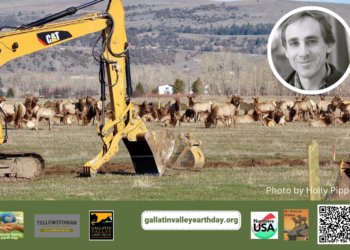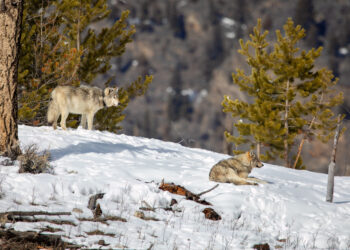Dismissing the science in favor of the hunter
By Benjamin Alva Polley EBS COLUMNIST
On Dec. 19, Montana’s Fish and Wildlife Commission eliminated season-ending quotas for female black bears in Region 1, located in northwestern Montana. This change was enacted through a no-notice amendment, effectively barring public participation unless individuals attended the meeting or joined via Zoom call. This undermined transparency and public engagement in wildlife management.
Numerous biologists have expressed grave concerns regarding this decision, as they aim to safeguard the declining black bear population. Jeff Burrows, the commissioner for Region 2 in west-central Montana, pushed for the amendment to scrap the quota that would have ended the spring bear hunt if female bear harvests exceeded 37%.
The FWP commission, including Burrows and Region 1 Vice Chair Pat Tabor, approved the 37% quota in February 2024. The original proposal sought to extend the spring bear hunting season by two weeks to reduce the number of female black bears killed. However, the commission made a complete reversal by December.
Tabor pressured the department to extend the spring hunting season in four districts of Region 1 earlier in 2024, citing complaints from hunters about a short season and claims that ungulate populations—including deer, elk and moose—were in decline. This raises serious public concerns, especially considering Tabor’s ownership of an outfitting business that stands to profit from extended hunting seasons in Region 1, particularly in Bear Unit 130, where he operates.
Historically, Region 1 has hosted the highest density of black bears in Montana, boasting the most favorable habitats, but recent changes threaten this balance. Tabor states that the black bear population should be reduced to boost the elk population. His assertion that reducing black bear populations is necessary to benefit elk lacks credible evidence. No recent studies of black bear demographics have been done in Region 1 since 2010. Black bears can and do kill newborn elk calves, but typically, they do so only during the first month. This is from a joint study FWP did with the University of Montana in 2014 that looked at elk calves in the Bitterroot Mountain of western Montana.
Biologists are alarmed that eliminating the quota will have dire consequences for black bear populations, especially when 3% of hunters misidentify sex. During the Dec. 19 Zoom meeting, Region 1 Supervisor Neil Anderson pointed out that the 37% quota was established due to substantial pressures faced by black bears since 2021.
“We were coming off two years of almost record harvests of black bears. In 2021 and 2022, we harvested over 700 bears each year in Region 1 alone, totaling almost 1,500 in two years,” Anderson explained in the meeting. “Over the past two years, the black bear harvest dropped to 455 in 2023 and again last year. So, we have likely significantly impacted the black bear population in 2021 and 2022, even though the season ended on May 31.”
Both black and grizzly bears share the trait of low reproductive rates. Black bears typically reach breeding age at four or five years and only produce cubs once they are five or six, contingent on suitable habitat and food. Female black bears, primarily responsible for nurturing cubs, require more protection than males for the population’s overall health. If the percentage of killed females reaches over 40%, it becomes difficult for the bear population to remain stable or grow.
Tabor’s claims regarding a declining elk population are unsupported. The Montana Free Press reported that the elk population in Montana has surged to its highest level in over a century, with FWP biologists estimating around 175,000 elk—a 42% increase since 2005. Access issues are making elk sightings and hunts increasingly difficult, as most have relocated to private lands. Last year, FWP conducted an elk count and found that approximately 143,000 elk were on private property, challenging hunters. Historically, predators like wolves and grizzlies have been scapegoated by those seeking to profit from hunting, but the deeper problem is public access and loss of habitat.
Simultaneously, elk habitat in northwestern Montana is rapidly diminishing due to a significant state population increase. Since 2020, the state has welcomed nearly 51,000 people, with Region 1 alone—including Flathead (almost 10,000 new residents), Lake (2,196), Lincoln (2,293), Mineral (559), and Sanders (1,466) counties—undergoing dramatic population growth. As land is purchased and habitat becomes fragmented, wildlife populations, including black bears, suffer. Each month, Montana loses 1,500 acres of open space to development.
According to FWP, northwest Montana’s elk and black bear populations lack thorough documentation. In certain areas of Lincoln County, the elk population is so dense that it damages private property, and FWP has allowed more elk hunts during the shoulder season.
In the February commission meeting, Tabor publicly chastised biologists for questioning his decisions, asserting that they should not challenge proposals from FWP leadership. He openly suggested that FWP should prioritize hunters’ voices over scientific input.
“I’m concerned when the wildlife managers come together as a group and make a decision,” Tabor said. “I recognize some people have different philosophies and belief systems, but ultimately, it’s one decision by one department, not multiple departments. I’m troubled by the fact that if regions don’t like the answer that both commissioners come up with, then the department has the official response that they work behind the scenes and try to undo that, which is bothersome to me.”
Tensions heated up amongst the commissioners during this Feb. 4 meeting as Commissioner K.C. Walsh of Region 4 responded.
“I find that kind of an irritating response from Commissioner Tabor,” Walsh said. “… I would add that there are seven commissioners for a reason, and we interpret public comment differently, and we hear different things in our region than maybe you do. From the same standpoint, there is one department, but there are seven of us, and we may have different points of view.”
Commissioner Susan Kirby Brooke from Region 3 also responded, noting that listening to the science is crucial when making informed decisions.
“I feel like as a Region Three Commissioner, I should be able to ask the biologists—whether they are fish biologists or wildlife biologists—questions and get answers about Region Three,” she said. “… I feel like I need to be able to go to these people and have them give me their professional opinion, even if the department has taken an official position.”
When did one of the world’s most esteemed wildlife management agencies become subservient to special interest groups and begin disregarding scientific evidence? Why are Pat Tabor and the commission sidestepping scientific data from their own department? Tabor is prioritizing his business interests rather than the well-being of the wildlife he was appointed to protect.
It’s great for elected officials to listen to hunters in the field, but it needs to be coupled with expertise and data from scientists when making decisions that affect wildlife populations. Under leadership like this, black bear populations in Region 1 could collapse.
Benjamin Alva Polley is a place-based storyteller. His stories have been published in Audubon, Esquire, Field & Stream, The Guardian, Outside, Popular Science, Sierra, and other publications on his website. He holds a master’s in Environmental Science and Natural Resource Journalism from the University of Montana.













